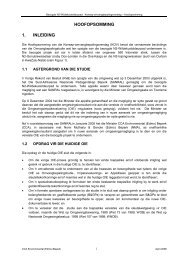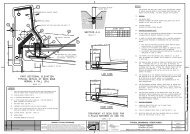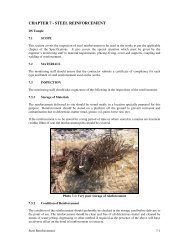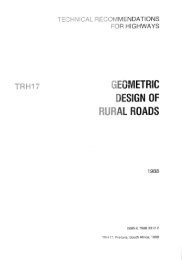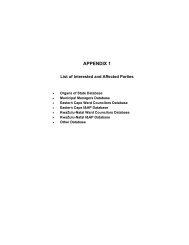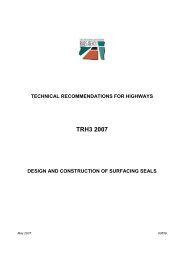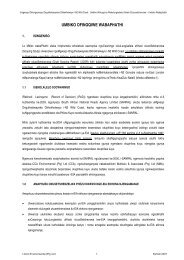SAPEM Chapter 2 - Sanral
SAPEM Chapter 2 - Sanral
SAPEM Chapter 2 - Sanral
You also want an ePaper? Increase the reach of your titles
YUMPU automatically turns print PDFs into web optimized ePapers that Google loves.
South African Pavement Engineering Manual<br />
<strong>Chapter</strong> 2: Pavement Composition and Behaviour<br />
4. PAVEMENT STRUCTURE<br />
The pavement structure is the combination of layers and subgrade that carries the traffic loads. A typical pavement<br />
layered structure and names for each layer used in contemporary road construction, Figure 8, is not that far removed<br />
from the Roman approach, it is just more refined. The pavement engineer needs to understand the particular<br />
behaviour of each layer and how this influences the layer’s ability to fulfil its purpose. For example, the base layer’s<br />
ability to spread loads onto the underlying layer and support the surface is of particular importance.<br />
Concrete (15 to 35 cm) surfacing and base<br />
Subbase usually cemented<br />
Selected subgrade<br />
Subgrade<br />
Flexible Pavements<br />
Figure 8.<br />
Typical Pavement Structures<br />
Rigid Pavements<br />
The purposes of the various layers in the pavement are described below:<br />
Surfacing: This is a functional wearing course that provides waterproofing, skid resistance, noise-damping,<br />
durability against the elements, visibility and drainage. For surfaced roads, the upper layer is bound, consisting<br />
of spray seals, asphalt or concrete.<br />
Base: This is a load spreading layer that is the most important structural component of the pavement. The layer<br />
must provide the required support for the surfacing and distribute the very high tyre pressures and wheel loads<br />
uniformly over the underlying layers and subgrade. The base comprises bound material, e.g., asphalt, concrete or<br />
stabilised, or it can be unbound, e.g., crushed stone or gravel base.<br />
Subbase: This layer provides support for the base as well as a platform upon which to construct a structural<br />
base layer of high integrity. It also protects the underlying selected subgrade layer by further spreading the load.<br />
Selected subgrade: These layers are primarily capping for the subgrade to provide a workable platform to<br />
construct the imported pavement layers. At the same time, these layers provide depth of cover over the<br />
subgrade to reduce the stresses in the subgrade to acceptable levels.<br />
Subgrade: This is the existing material upon which the pavement must be constructed. It can be modified with<br />
stabilisers to reduce plasticity, ripped and recompacted to achieve uniform support, or undercut and replaced,<br />
depending on its quality.<br />
Typically, the higher up the layer is in the pavement structure, the more expensive the material to obtain or<br />
manufacture. The asphalt surfacing in a pavement layer is generally the most expensive layer in the pavement<br />
structure. It is also typical for the stiffer pavement layers to be at the top of the pavement structure. The exception<br />
to this is “inverted” flexible pavements, where the subbase layer is cement stabilised and the base layer is a good<br />
quality granular layer. These pavements are widely used in South Africa.<br />
4.1 Pavement Design<br />
Pavement design is the process to decide on the pavement structure, in terms of the type of structure, the materials<br />
to be used and the layer thicknesses. The basic objective of pavement design is to combine materials of sufficient<br />
strength in a layered system of to provide the desired functional and structural service levels over the design period,<br />
subject to the applicable traffic demand and particular environment. The functional and structural service levels, the<br />
rates at which these service levels deteriorate, the cost associated with the provision and maintenance of these<br />
service levels and the savings by the road users resulting from improved service levels determine the economic<br />
viability of a design. Although the final design decision is dictated by the most economically viable design, the<br />
process of ensuring that a pavement with adequate strength is provided is critical.<br />
The philosophy, principles and details of several different design methods applicable to new pavements and<br />
pavement requiring rehabilitation are included in <strong>Chapter</strong> 10.<br />
Section 4: Pavement Structure<br />
Page 10





